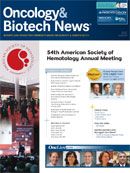Publication
Article
Oncology & Biotech News
Novel TKI Quizartinib Sparks Remission in Some Patients With Resistant AML
Author(s):
Quizartinib, an investigational tyrosine kinase inhibitor, demonstrated a clinical benefit in patients with a particularly deadly form of acute myeloid leukemia.
Mark Levis, MD, PhD
Quizartinib, an investigational tyrosine kinase inhibitor, demonstrated a clinical benefit in patients with a particularly deadly form of acute myeloid leukemia (AML) in results of a phase II study presented during the 54th Annual Meeting of the American Society of Hematology.
Quizartinib (formerly AC220) is the only single-agent treatment that has been shown to benefit patients with FMS-like tyrosine kinase 3 internal tandem duplications (FLT3-ITD) who have failed previous therapy, said Mark Levis, MD, PhD, lead author of the study and associate professor of Oncology, Pharmacology, and Medicine at the Sidney Kimmel Comprehensive Cancer Center at Johns Hopkins Medicine in Baltimore, Maryland.
In 37% of the study’s 333 participants, the oral drug generated a long enough remission to allow a hematopoietic stem-cell transplant, Levis said. Of the patients who received transplants, he said, 18 appear to be cured.
Levis added that, of patients who did not respond to their last AML therapy, 79% of those with FLT3-ITD and 48% of those without the mutation achieved a partial response or better with quizartinib.
The FLT3-ITD mutation, present in 25% of AML patients, causes leukemia cells to spread more aggressively, growing back immediately after standard chemotherapy, Levis said. Quizartinib is the first drug designed specifically as an FLT3 inhibitor, he said, and is 10% to 50% more potent in humans than any other agent that inhibits FLT3.
In the study, the 333 patients were divided into two treatment cohorts. Cohort 1 consisted of patients aged 60 years or over with the FLT3-ITD mutation who failed to achieve remission with standard chemotherapy, or who had recently relapsed for the first time. Cohort 2 consisted of patients aged >18 years with the FLT3-ITD mutation who presented with relapsed or refractory AML and had been administered salvage chemotherapy after failing to respond to prior treatment, or had relapsed after a stem-cell transplant. Most patients in the study had the FLT3-ITD mutation, but a small number in each cohort lacked the mutation.
The primary endpoint was the composite complete remission rate (CRc) of all patients, which includes complete remission (CR; no active disease), complete remission with incomplete platelet recovery (CRp; no active disease but abnormal platelet count), and complete remission with incomplete hematologic recovery (CRi; no active disease but abnormal red and white blood cell counts).
In his presentation, Levis focused on Cohort 2. The prognosis for the 138 patients in that cohort was extremely poor, with survival measurable in weeks, Levis said.
The patients, 100 with the mutation and 38 without, received continuous treatment with quizartinib at a fixed dose during 28-day cycles.
Following one to three cycles, researchers observed a CRc rate of 46% (6% CR or CRp, and 40% CRi) in patients with the FLT3-ITD mutation, with a median duration of response of 12.1 weeks. In patients without the mutation, researchers observed a 32% CRc rate (6% CR or CRp, and 26% CRi) with a median duration of response of 7 weeks.
Median overall survival (OS) for mutation-positive patients was 22.9 weeks versus 25.6 weeks for mutation-negative patients. Better outcomes were seen in patients who went on to receive stem-cell transplant. Transplant patients with the FLT3-ITD mutation had a median OS of 33.3 weeks, versus 17.7 weeks for patients who did not undergo transplant. For transplant patients without the mutation, median OS was 20.8 weeks for those who did not receive a transplant; for those who did undergo transplant, median OS has not yet been reached.
Adverse events observed in more than 20% of patients included QT prolongation (26%), which was managed by dosage reduction, nausea (38%), vomiting (26%), anemia (29%), fever (25%), diarrhea (20%), and fatigue (20%).
The study’s results demonstrate that quizartinib can produce a high treatment response rate in a group of very poor-prognosis AML patients with manageable toxicity, Levis said.
“We plan to use these encouraging results to design and conduct additional randomized trials that will hopefully lead to the approval of quizartinib to make it accessible to those patients who previously had no hope for a cure,” he said.
Ideally, Levis said, quizartinib will be used in combination with existing therapies, and in earlier-stage AML patients. “This is a drug that’s crying out to be used very early on, when these patients come in at diagnosis, to prevent this relapse from occurring in the first place. I don’t think we’ll see resistance problems if we give it in a newly diagnosed setting.”
If approved in AML, Levis added, quizartinib is likely to be tested in other cancer types. One is acute lymphoblastic leukemia, in which FLT3 is sometimes mutated or overexpressed. Since quizartinib also inhibits the expression of KIT mutations, it is likely to work in patients who have gastrointestinal stromal tumors, he added.
Levis MJ, Perl AE, Dombret H, et al. Final results of a phase II open-label, monotherapy efficacy and safety study of quizartinib (AC220) in patients with FLT3-ITD positive or negative relapsed/refractory acute myeloid leukemia after second-line chemotherapy or hematopoietic stem cell transplantation. Blood. (ASH Annual Meeting Abstracts). 2012;120(21): abstr 673.










